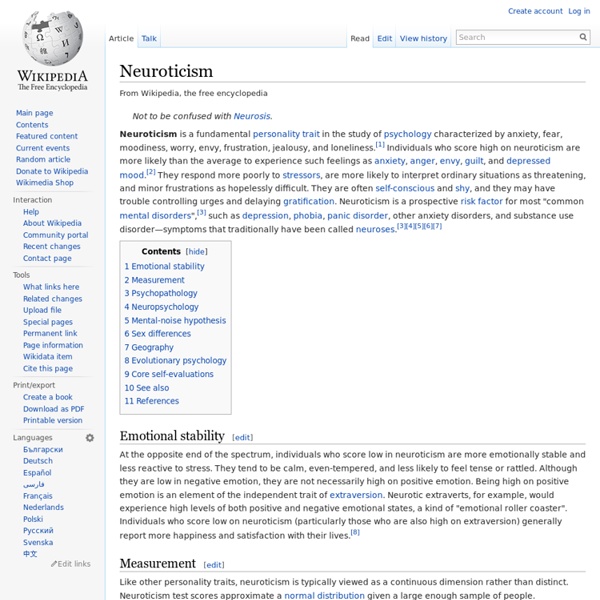APA Research Style Crib Sheet
APA Research Style Crib Sheetby Russ DeweyGeorgia Southern University Psychology Department [Emeritus] [This page is a summary of rules for using APA style, updated for the 6th edition. I have made every effort to keep this document accurate, but readers have occasionally pointed out errors and inconsistencies which required correction.
Personality Types
New Content The Primary Passions [05.15.03] Long & Sedley (pp. 410-11) translate Strobaeus [speaking for the Stoics]: "[O]ne must suppose that some passions are primary and dominant, while others have these as their reference. The generically primary ones are these four: appetite, fear, distress, pleasure. (4) Appetite and fear come first, the former in relation to what appears good, and the latter in relation to what appears bad. Pleasure and distress result from these: pleasure whenever we get the objects of our appetite or avoid the objects of our fear; distress, whenever we fail to get the objects of our appetite or experience the objects of our fear."
Extroversion and introversion
The trait of extraversion–introversion is a central dimension of human personality theories. The terms introversion and extraversion were first popularized by Carl Jung,[1] Although both the popular understanding and psychological age differ from his original intent. Extraversion tends to be manifested in outgoing, talkative, energetic behavior, whereas introversion is manifested in more reserved and solitary behavior.[2] Virtually all comprehensive models of personality include these concepts in various forms. Examples include the Big Five model, Jung's analytical psychology, Hans Eysenck's three-factor model, Raymond Cattell's 16 personality factors, the Minnesota Multiphasic Personality Inventory, and the Myers–Briggs Type Indicator.
How to Stop Worrying
Undoing the Worrying Habit Once acquired, the habit of worrying seems hard to stop. We're raised to worry and aren't considered "grown up" until we perfect the art. Teenagers are told: "you'd better start worrying about your future". If your worries aren't at least as frequent as your bowel movements, you're seen as irresponsible, childish, aimless.
Mental Health: Hallucinations to Delusions
Mental health is tricky since there are many types of diagnosis, together with personality disorders, cognitive disorder, mental diseases and so forth. To understand mental health entirely is nearly impossible, but there are many answers to questions that many have, because all of us directly or indirectly are affected by mental illnesses. Hallucinations Some disorders, diseases, or cognitive impairments may cause a person to hallucinate or become delusional.
Two-factor models of personality
Beginnings[edit] The Roman physician Galen mapped the four temperaments (sanguine, phlegmatic, choleric and melancholic) to a matrix of hot/cold and dry/wet, taken from the four classical elements.[1] Two of these temperaments, sanguine and choleric, shared a common trait: quickness of response (corresponding to "heat"), while the melancholic and phlegmatic shared the opposite, a longer response (coldness). The melancholic and choleric, however, shared a sustained response (dryness), and the sanguine and phlegmatic shared a short-lived response (wetness). This meant that the choleric and melancholic both would tend to hang on to emotions like anger, and thus appear more serious and critical than the fun-loving sanguine, and the peaceful phlegmatic.
Anxiety: Forms of Anxiety
Anxiety is a complex emotion, and its signs and symptoms may be manifested in different ways. Following are brief descriptions of the forms of anxiety that may occur in children and teenagers. Detailed descriptions, signs and symptoms, causes, treatment and related information can be found by linking to each disorder. {*style:<ul>*}{*style:<li>*}{*style:<b>*}Separation Anxiety Disorder{*style:</b>*} — Children with separation anxiety disorder (SAD) have intense anxiety about being away from home or caregivers that affects their ability to function socially and in school. The child may cling to parents, refuse to go to school, or be afraid to sleep alone. {*style:<a href=' more{*style:</a>*}.
Herd Behaviour
AS & A2 Economics - Intensive Exam Coaching & Revision Workshops: Book Now! Stratford | Fulham | Bristol | Birmingham | Gateshead | Leeds | Manchester Monday, November 28, 2011 PrintEmailTweet This!Save to Favorites Professor Andrew Oswald from the University of Warwick delivered a pitch-perfect lecture on the significance of herd behaviour in his talk at the LSE tonight.



